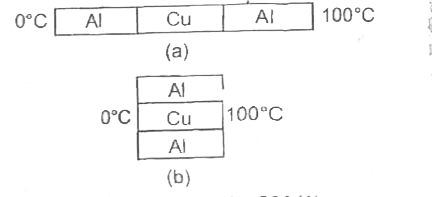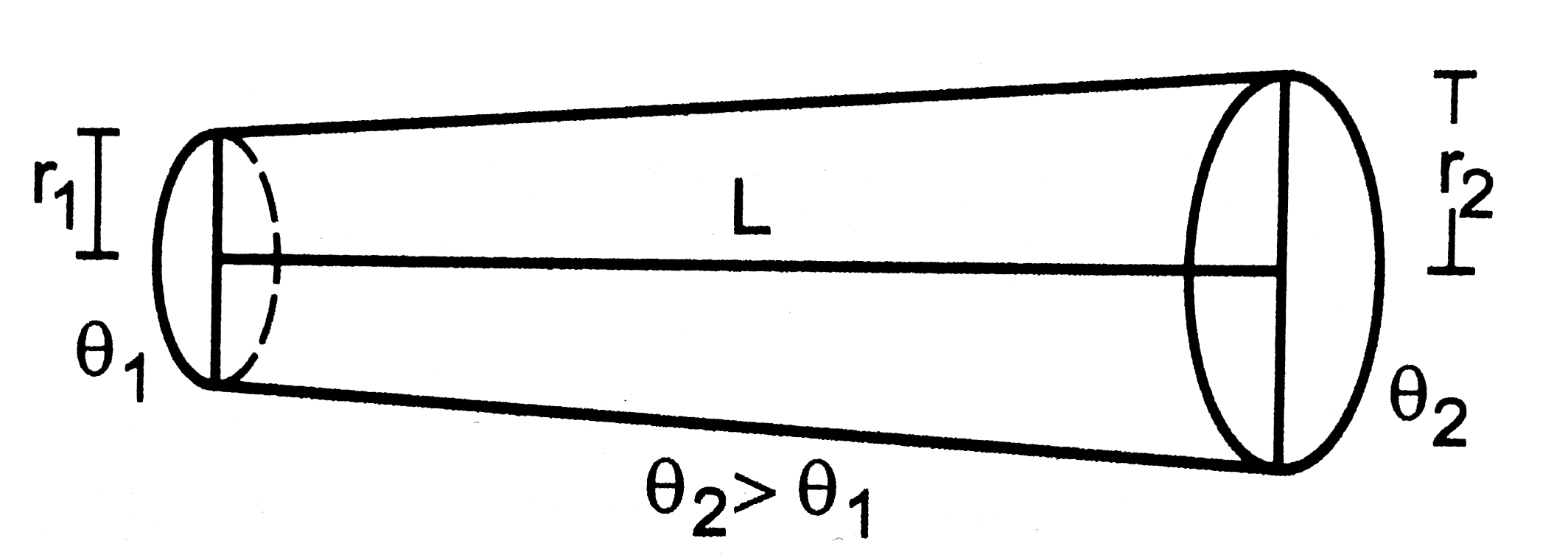EXERCIESE from HC VERMA HEAT TRANSFER for Class 11
| Class 11 | PHYSICS |
| Chapter | HEAT TRANSFER |
| HC VERMA | EXERCIESE |
| Medium | English |
| Academic Year | 2023-2024 |
Question 2
A liquid-nitrogen container is made of a 1−cm thick styrofoam sheet having thermal conductivity 0.025Js−1m−1C−1 . Liquid nitrogen at 80K is kept in it. A total area of 0.80m2 is in contact with the liquid nitrogen. The atmospheric temperature is 300K . Calculate the rate of heat flow from the atmosphere to the liquid nitrogen. View SolutionQuestion 3
The normal body-temperature of a person is 97∘F . Calculate the rate at which heat is flowing out of his body through the clothes assuming the following values. Room temperature =47∘F , surface of the body under clothes =1.6m2 , conductivity of the cloth =0.04Js−1m−1C−1 , thickness of the cloth =0.5cm. View SolutionQuestion 5
One end of a steel rod (K=46Js−1m−1C−1) of length 1.0m is kept in ice at 0∘C and the other end is kept in boiling water at 100∘C . The area of cross section of the rod is 0.04cm2 . Assuming no heat loss to the atmosphere, find the mass of the ice melting per second. Latent heat of fusion of ice =3.36×105Jkg−1 .View SolutionQuestion 6
An icebox almost completely filled with ice at 0∘C is dipped into a large volume of water at 20∘C . The box has walls of surface area 2400cm2 thickness 2.0mm and thermal conductivity 0.06Wm−1C−1 . Calculate the rate at which the ice melts in the box. Latent heat of fusion of ice =3.4×105Jkg−1 .View SolutionQuestion 7
A pitcher with 1−mm thick porous walls contain 10kg of water. ,Water comes to its outer surface and evaporates at the rate of 0.1gs−1 . The surface area of the pitcher (one side) =200cm2 . The room temperature =42∘C , latent heat of vaporization =2.27×106Jkg−1 , and the thermal conductivity of the porous walls =0.80js−1m−1C−1 . Calculate the temperature of water in the pitcher when it attains a constant value. View SolutionQuestion 9
Water at 50∘C is filled in a closed cylindrical vessel of height 10cm and cross sectional area 10cm2 The walls of the vessel are adiabatic but the flat parts are made of 1−mm thick aluminium (K=200Js−2m−1C−1 . Assume that the outside temperature is 20∘C . The density of water is 1000kgm−3 and the specify heat capacity of water =4200Jkg−1C−1 .Estimate the time taken for the temperature to fall by 1.0∘C . Make any simplifying assumption you need but specify them.View SolutionQuestion 10
The left end of a copper rod (length=20cm, Area of cross section=0.2cm2) is maintained at 20∘C and the right end is maintained at 80∘C . Neglecting any loss of heat through radiation, find (a) the temperature at a point 11cm from the left end and (b) the heat current through the rod. thermal conductivity of copper =385Wm−1C−1 .View SolutionQuestion 12
A cubical box of volume 216cm3 is made up of 0.1cm thick wood, The inside is heated electrically by 100W heater. It is found that the temperature difference between the inside and the outside surface 5∘C in steady state . Assuming that the entire electrically energy spent appears as heat, find the thermal conductivity of the material of the box.View SolutionQuestion 13
Figure shows water in a container having 2.0−mm thick walls made of a material of thermal conductivity 0.50Wm−1C−1 . The container is kept in a melting-ice bath at 0∘C . The total surface area in contact with water is0.05m2 . A wheel is clamped inside the water and is coupled to a block of mass M as shown in the figure. As the goes down, the wheel rotates. It is found that after some time a steady state is reached in which the block goes down with a constant speed of 10cms−1 and the temperature of the water remains constant at 1.0∘C .Find the mass M of the block. Assume that the heat flow out of the water only through the walls in contact. Take g=10ms−2 .
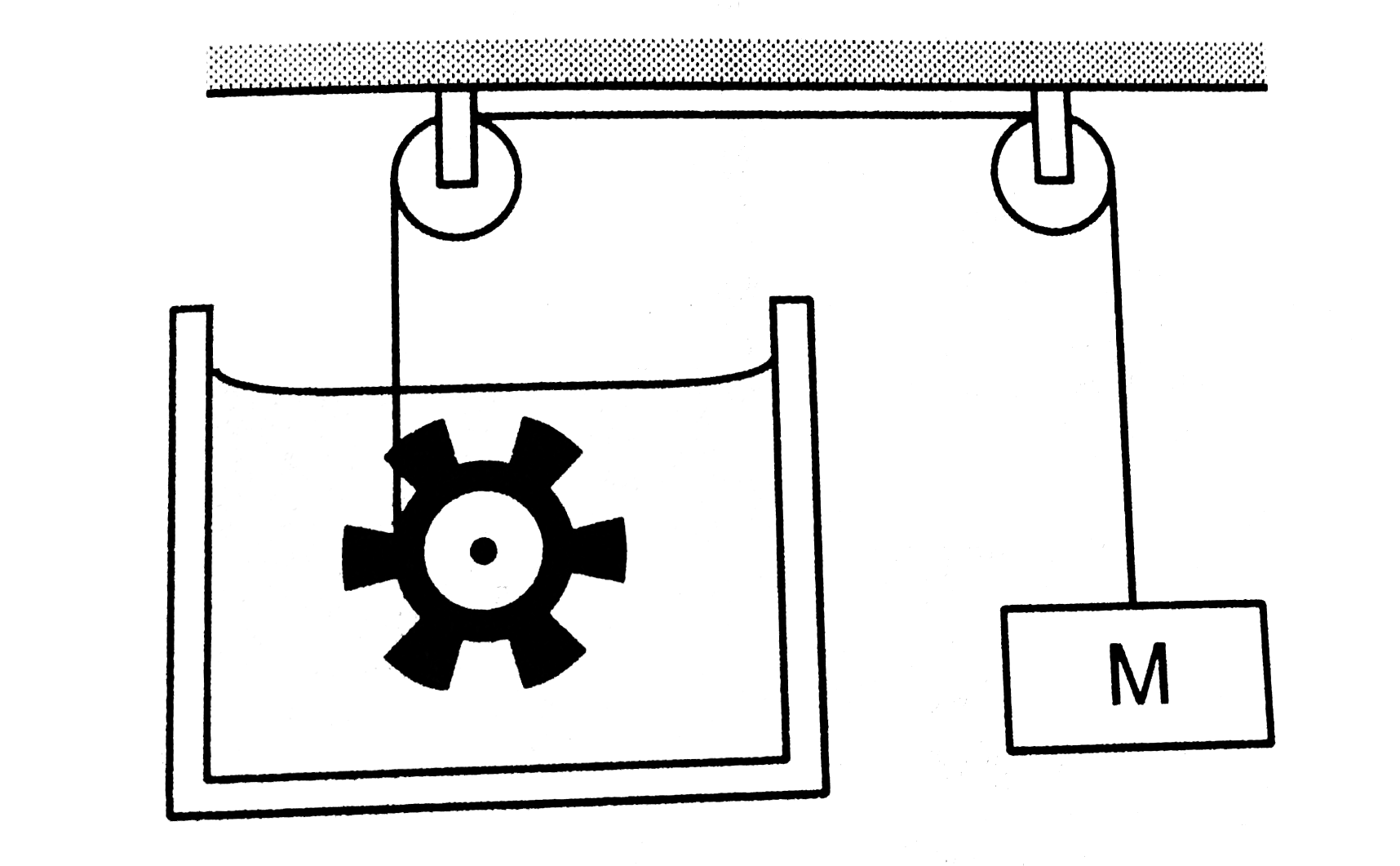 View Solution
View SolutionQuestion 14
On a winter day when the atmospheric temperature drops to −10∘C , ice forms on the surface of a lake. (a) Calculate the rate of increases of thickness of the ice when 10cm of ice is already formed. (b) Calculate the total time taken in forming 10cm of ice. Assume that the temperature of the entire water reaches 0∘C before the ice starts forming. Density of water =1000kgm−3 , latent heat of fusion of ice =3.36×105Jkg−1 and thermal conductivity of ice =1.7Wm−1C−1 . Neglect the expansion of water on freezing.View SolutionQuestion 15
Consider the situation of the previous problem. Assume that the temperature of the water at the botton of the lake remains constant at 4∘C as the ice forms on the surface (the heat required to maintain the temperature of the bottom layer may come from the bed of the lake). The depth of the lake is 1.0m. Show that the thickness of the ice formed attains a steady state maximum value. Find this value. The thermal conductivity of water =0.50Wm−1.∘C−1 . Take other relevent data form the previous problelm.View SolutionQuestion 16
Three rods of lengths 20cm each and area of cross section 1cm2 are joined to from a triangle ABC. The conductivities of the rods are kAB=50Js−1m−1C−1 , kBC=200Js−1m−1C−1 , and kAC=400Js−1m−1C−1 . The junction A,B and C are maintained at 40∘C , 80∘C and 80∘C respectively. Find the rate of heat flowing through the rods AB, AC and BC . View SolutionQuestion 17
A semicircular rods is joined at its end to a straight rod of the same material and the same cross-sectional area. The straight rod forms a diameter of the other rod. The junctions are maintained at different temperatures. Find the ratio of the heat transferred through a cross section of the straight rod in a given time. View SolutionQuestion 18
A metal rod of cross sectional area 1.0cm2 is being heated at one end. At one time , the temperature gradient is 5.0∘Ccm−1 at cross section A and is 2.5∘Ccm−1 at cross section B. calculate the rate at which the temperature is increasing in the part AB of the rod. The heat capacity of the part AB=0.40J∘C−1 , thermal conductivity of the material of the rod. K=200Wm−1C−1 . Neglect any loss of heat to the atmosphere.View SolutionQuestion 20
A hole of radius r1 is made centrally in a uniform circular disc of thickness d and radius r2 . The inner surface (a cylinder of length d and radius r1) is maintained at a temperature θ1 and the outer surface (a cylinder of length d and radius r2) is maintained at a temperature θ2(θ1>θ2) .The thermal conductivity of the material of the disc is K. Calculate the heat flowing per unit time through the disc.View SolutionQuestion 21
A hollow tube has a length l, inner radius R1 and outer radius R2 . The material has a thermal conductivity K. Find the heat flowing through the walls of the tube if (a) the flat ends are maintained at temperature T1 and T2(T2>T1) (b) the inside of the tube is maintained at temperature T1 and the outside is maintained at T2 .View SolutionQuestion 23
Figure shows a copper rod joined to a steel rod. The rods have equal length and and the equal cross sectional area. The free end of the copper rod is kept at 0∘C and that of the steel rod is kept at 100∘C . Find the temperature at the junction of the rods. conductivity of copper =390Wm−1C−1 and that of steel =46Wm−1C−1 .
 View Solution
View SolutionQuestion 24
An aluminium rod and a copper rod of equal length 1.0m and cross-sectional area. 1cm2 are welded together as shown in figure. One end is kept at a temperature of 20∘C and the other at 60∘C Calculate the amount of heat taken out per second from the hot end. thermal conductivity of aluminium =200Wm−1C−1 and of copper =390Wm−1C−1 .
 View Solution
View SolutionQuestion 25
Figure shows an aluminium rod joined to a copper rod. Each of the rods has a length of 20cm and area of cross section 0.20cm2 . The junction is maintained at a constant temperature 40∘C and the two ends are maintained at 80∘C . Calculate the amount of heat taken out from the cold junction in one minute after the steady state is reached. The conductivities are KAl=200Wm−1C−1 . and KCu=400Wm−1C−1 .
 View Solution
View SolutionQuestion 26
Conside the situation shown in figure. The frame is made of the same material and has a unifrom cross-section area everywhere. Calculate the amount of heat flowing per second through a cross section of the bent part if the total heat taken out per second from the end at 100∘C is 130J .
 View Solution
View SolutionQuestion 28
A room has s window fitted with a single 1.0m×2.0m glass of thickness 2mm. (a) Calculate the rate of heat flow through the closed window when the temperature inside the room is 32∘C and that outside is 40∘C . (b) The glass is now replaced by two glasspanes, each having a thickness of 1mm and separated by a distance of 1mm. Calculate the rate of heat flow under the same condition of temperature. Thermal conductivity of window glass =1.0Js−1m−1C−1 and that of air =0.025Js−1m−1C−1 .View SolutionQuestion 31
Four identical rods AB, CD, CF and DE are joined as shown in figure. The length, cross-sectional area and thermal conductivity of each rod are l, A and K respectively. The ends A, E and F are maintained at temperature T1 , T2 and T3 respectively. Assuming no loss of heat to the atmosphere, find the temperature at B.
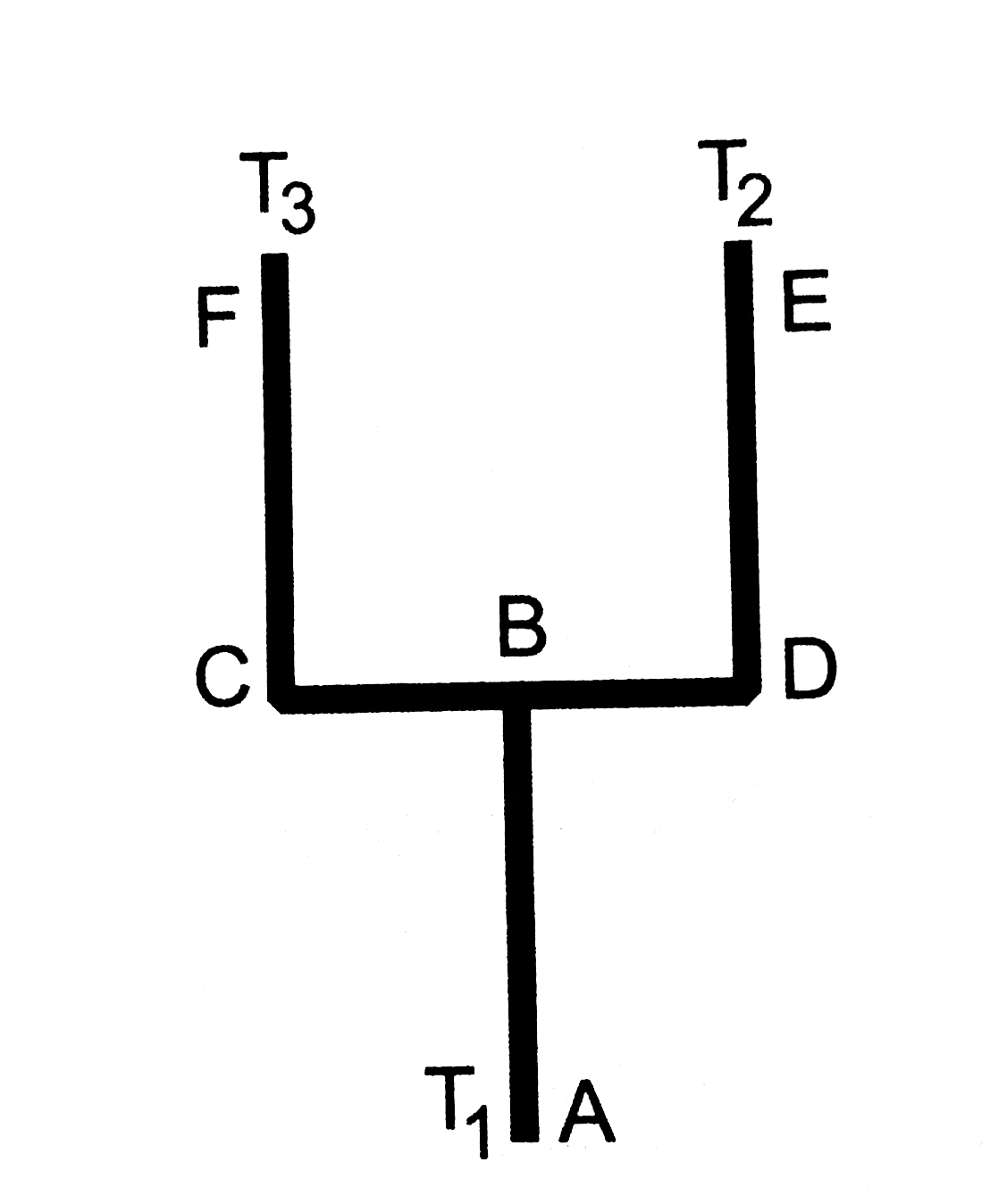 View Solution
View SolutionQuestion 32
Seven rods A, B, C, D, E, F and G are joined as shown in figure. All the rods have equal cross-sectional area A and length l. The thermal conductivities of the rods are KA=KC=K0, KB=KD=2K0, KE=3K0, KF=4K0 and KG=5K0 . The rod E is kept at a constant temperature T1 and the rod G is kept at a constant temperature T2(T2>T1) . (a) Show that the rod F has a uniform temperature T=(T1+2T2)/3 . (b) Find the rate of heat flowing from the source which maintains the temperature T2 .
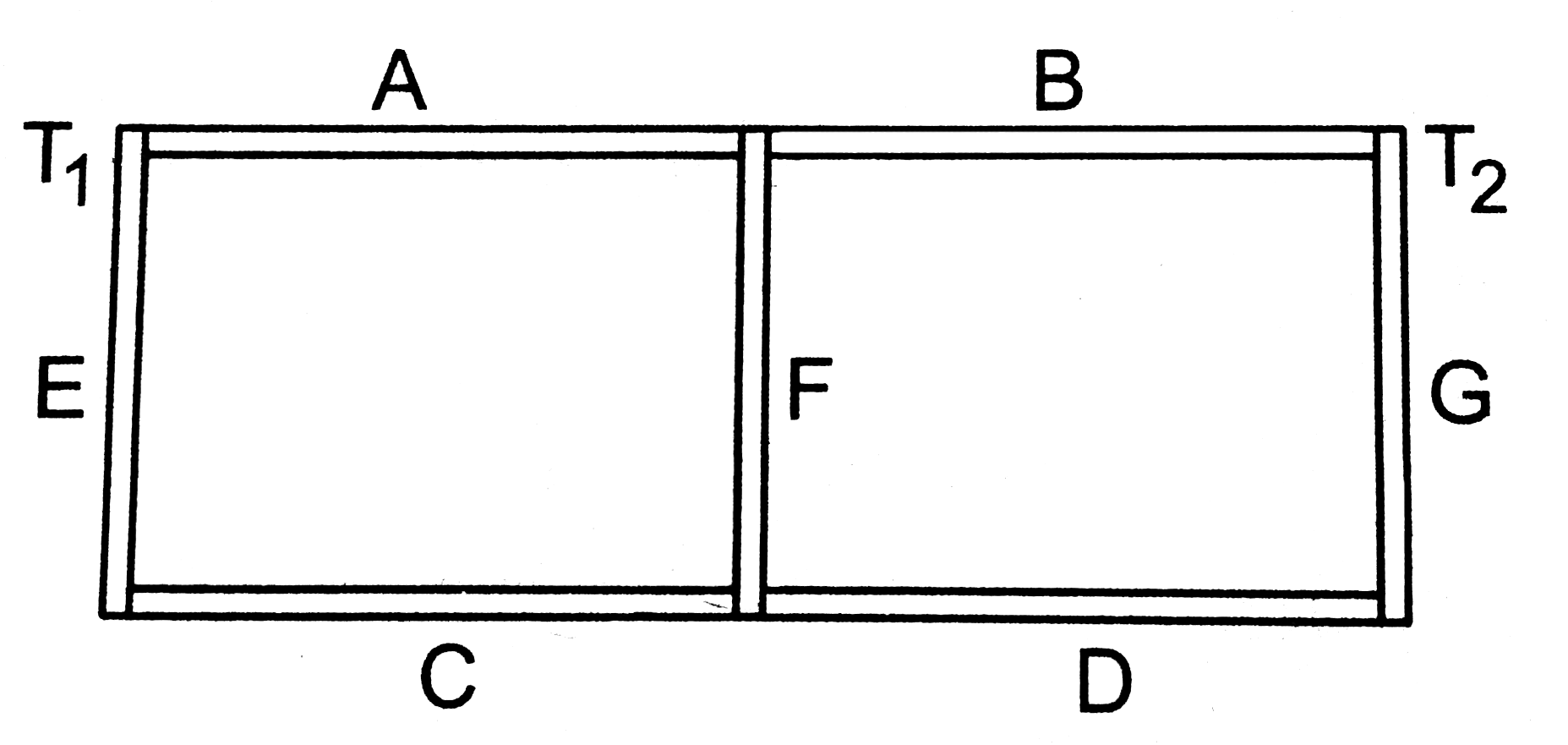 View Solution
View SolutionQuestion 34
A rod of negligible heat capacity has length 20cm, area of cross section 1.0cm2 and thermal conductivity 200Wm−1C−1 . The temperature of one end is maintained at 0∘C and that of the other end is slowly and linearly varied from 0∘C to 60∘C in 10 minutes. Assuming no loss of heat through the sides, find the total heat transmitted through the rod in these 10 minutes.View SolutionQuestion 38
A gas is enclosed in a cylindrical vessel fitted with a frictionless piston.the gas is slowly heated for some time. During the process, 10 J of heat is supplied and the piston is found to move out 10cm. Find the increase in the internal energy of the gas, the area of cross section of the cylinder=4cm2 and the atmospheric pressure =100kPa. View SolutionQuestion 43
A spherical ball of surface area 20cm2 absorbs any radiation that falls on it. It is suspended in a closed box maintained at 57∘C . (a) Find the amount of radiation falling on the ball per second. (b) Find the net rate of heat flow to or from the ball at an instant when its temperature is 200∘C . Stefan constant =6.0×10−sWm−2K−4 . View SolutionQuestion 44
A spherical tungsten pieces of radius 1.0cm is suspended in an evacuated chamber maintained at 300K. The pieces is maintained at 1000K by heating it electrically. Find the rate at which the electrical energy must be supplied. The emissivity of tungsten is 0.30 and the Stefan constant σ is 6.0×10−sWm−2K−4 . View SolutionQuestion 45
A cubical block of mass 1.0kg and edge 5.0cm is heated to 227∘C . It is kept in an evacuated chamber maintained at 27∘C . Assming that the block emits radiation like a blackbody, find the rate at which the temperature of the block will decreases. Specific heat capacity of the material of the block is 400Jkg−1K−1 .View SolutionQuestion 46
A copper sphere is suspended in an evacuated chamber maintained at 300K. The sphere is maitained at a constant temperature of 500K by heating it electrically. A total of 210W is electric power is needed to do it. When the surface of the copper sphere is completely blackned, 700W is needed to maintain the same temperature of the sphere. Calculate the emissivity of copper.View SolutionQuestion 47
A spherical ball A of surface area 20cm2 is kept at the centre of a hollow spherical shell B of area 80cm2 . The surface of A and the inner surface of B emit as blackbodies. Both A and B are at 300K. (a) How much is the radiation energy emitted per second by the ball A? (b) How much is the radiation energy emitted per second by the inner surface of B? (c) How much of the energy emitted by the inner surface of B falls back on this surface itself?View SolutionQuestion 48
A cylindrical rod of length 50cm and cross sectional area 1cm2 is fitted between a large ice chamber at 0∘C and an evacuated chamber maintained at 27∘C as shown in figure. Only small protions of the rod are insid ethe chamber and the rest is thermally insulated from the surrounding. The cross section going inti the evacuted chamber is blackened so that it completely absorbe any radiation falling on it. The temperatuere of the blackened end is 17∘C when steady state is reachhed. Stefan constant σ=6×10−sWm−2K−4 . Find the thermal conductivity of the material of the rod.
 View Solution
View SolutionQuestion 49
One end of a rod length 20cm is inserted in a furnace at 800K. The sides of the rod are covered with an insulating material and the other end emits radiation like a blackbody. The temperature of this end is 750K in the steady state. The temperature of the surrounding air is 300K. Assuming radiation to be the only important mode of energy transfer between the surrounding and the open end of the rod, find the thermal conductivity of the rod. Stefan constant σ=6.0×10−1Wm−2K−4 .View SolutionQuestion 50
A calorimeter of negligible heat capacity contains 100cc of water at 40∘C . The water cools to 35∘C in 5minutes. The water is now replaced by k-oil of equal volume at 40∘C . Find the time taken for the temperature to become 35∘C under similar conditions. Specific heat cpacities of water and K-oil are 4200Jkg−1K−1 and 2100Jkg−1K−1 respectively. Density of K-oil =800kgm−3 .View SolutionQuestion 53
A metal ball of mass 1kg is heated by means of a 20W heater in a room at 20∘C . The temperature of the ball becomes steady at 50∘C . (a) Find the rate of loss of heat to the surrounding when the ball is at 50∘C . (b) Assuming Newton's law of cooling, calculate the rate of loss of heat to the surrounding when the ball is at 30∘C . (c) Assume that the temperature of the ball rises uniformly from 20∘C to 30∘C in 5 minutes. Find the total loss of heat to the surrounding during this period. (d) Calculate the specific heat capacity of the metal.View SolutionQuestion 54
A metal block of heat capacity 90J/.∘C placed in a room at 25∘C is heated electrically. The heater is switched off when the temperature reaches 35∘C. The temperature of the block rises at the rate of 2∘C/s just after the heater is switched on and falls at the rate of 0.2∘C/s just after the heater is switched off. Assume Newton's law of cooling to hold (a) Find the power of the heater. (b) Find the power radiated by the block just after the heater is switched off. (c ) Find the power radiated by the block when the temperature of the block is 30∘C. (d) Assuming that the power radiated at 30∘C respresents the average value in the heating process, find the time for which the heater was kept on. View SolutionQuestion 55
A hot body placed in a surrounding of temperature θ0 obeys Newton's law of cooling dθdt=−k(θ−θ0) . Its temperature at t=0 is θ1 the specific heat capacity of the body is s and its mass is m. Find
(a) the maximum heat that the body can lose and
(b) the time starting from t=0 in which it will lose 90% of this maximum heat.View Solution
All Exercises from HC VERMA Class 11 PHYSICS HEAT TRANSFER
- EXERCIESE
- EXERCISES
- EXERCIESE
- EXERCISES
- EXERCIESE
- EXERCIESE
- EXERCISES
- EXERCIESE
- EXERCISES
- EXERCIESE
- EXERCIESE
- EXERCISES
- EXERCIESE
- EXERCISES
- EXERCIESE
- EXAMPLES
- EXAMPLES
- EXAMPLE
- EXAMPLES
- EXAMPLES
- EXAMPLE
- EXAMPLES
- EXAMPLES
- EXAMPLE
- OBJECTIVE 1
- OBJECTIVE 1
- OBJECTIVE I
- OBJECTIVE 1
- OBJECTIVE 1
- OBJECTIVE I
- OBJECTIVE 1
- OBJECTIVE 1
- OBJECTIVE I
- OBJECTIVE 2
- OBJECTIVE 2
- OBJECTIVE II
- OBJECTIVE 2
- OBJECTIVE 2
- OBJECTIVE II
- OBJECTIVE 2
- OBJECTIVE 2
- OBJECTIVE II
- SHORT ANSWER
- SHORT ANSWER
- QUESTIONS FOR SHORT ANSWER
- SHORT ANSWER
- SHORT ANSWER
- QUESTIONS FOR SHORT ANSWER
- SHORT ANSWER
- SHORT ANSWER
- QUESTIONS FOR SHORT ANSWER
- WORKED OUT EXAMPLES
- WORKED OUT EXAMPLES
- WORKED OUT EXAMPLES
- WORKED OUT EXAMPLES
- WORKED OUT EXAMPLES
- WORKED OUT EXAMPLES
- WORKED OUT EXAMPLES
- WORKED OUT EXAMPLES
- WORKED OUT EXAMPLES

